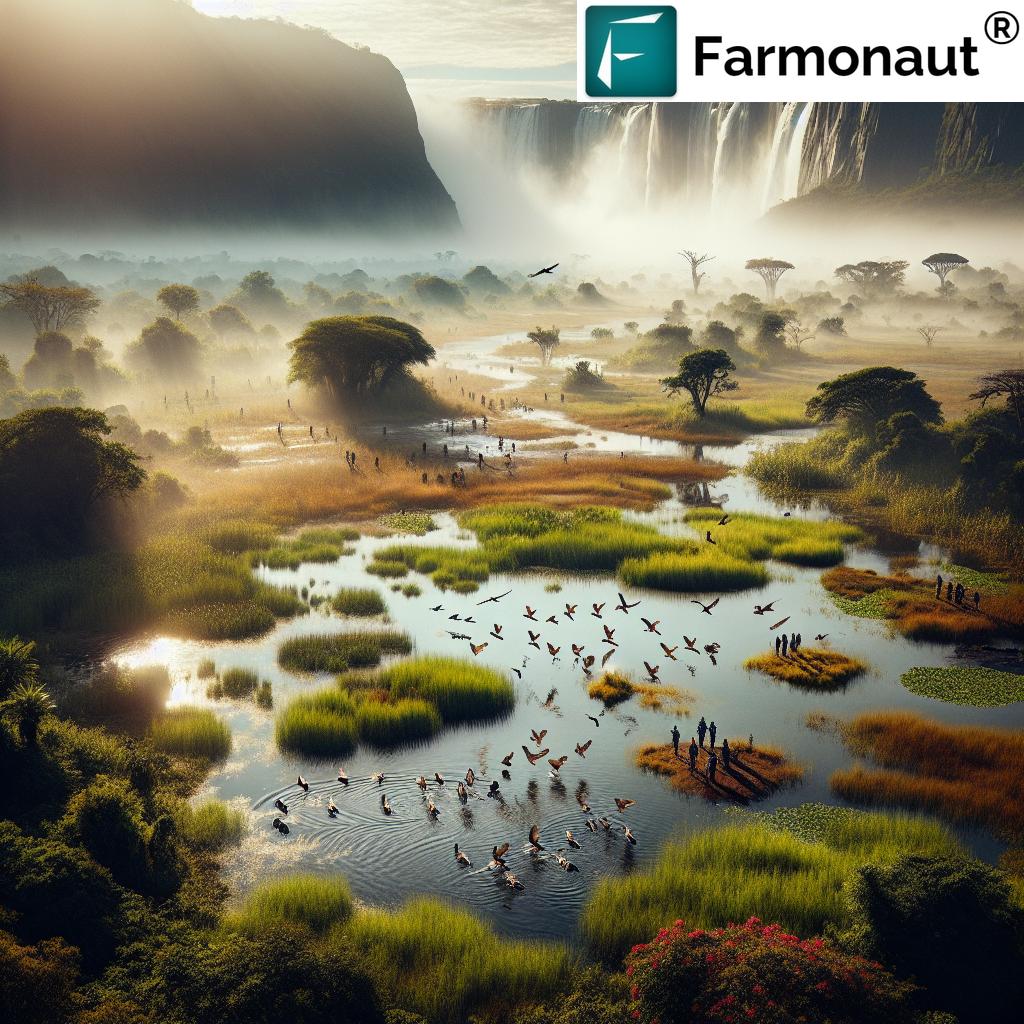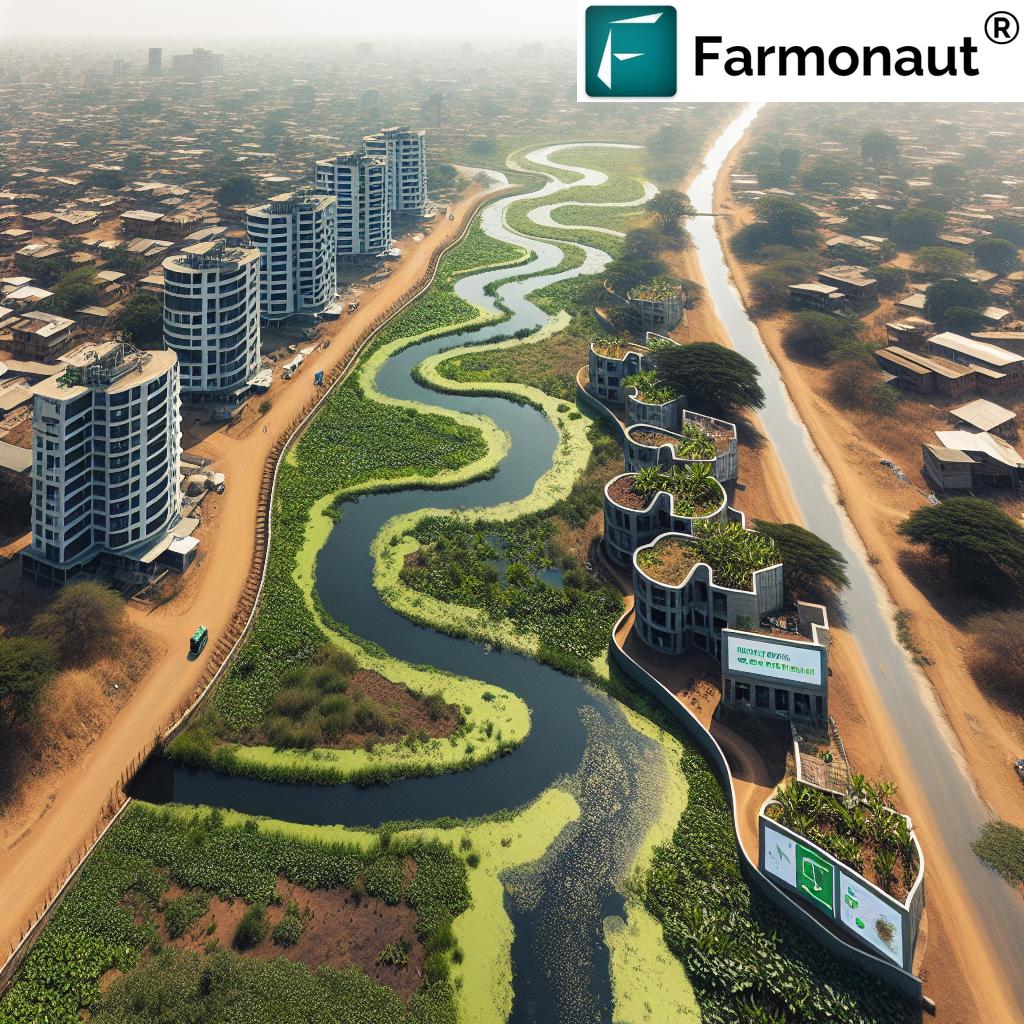Safeguarding Zimbabwe’s Wetlands: Sustainable Management for Climate Resilience and Biodiversity

“Zimbabwe has 7 Ramsar Convention sites and 92 wetland restoration projects nationwide, showcasing its commitment to conservation.”
As we delve into the critical issue of wetland conservation in Zimbabwe, we find ourselves at the crossroads of environmental stewardship and sustainable development. Our beautiful country, known for its diverse ecosystems, faces significant challenges in preserving its vital wetlands. These ecological treasures play a crucial role in our nation’s climate resilience, biodiversity, and water security. Today, we’ll explore the importance of wetlands for climate change mitigation, the pressing need for urban wetland protection, and Zimbabwe’s efforts towards sustainable wetland use.
The Significance of Wetlands in Zimbabwe’s Ecosystem
Wetlands, locally known as matoro or amaxhaphozi, are areas where water saturates the soil either permanently or seasonally. These unique ecosystems serve as nature’s multitaskers, performing various essential functions:
- Natural water treatment systems
- Flood control mechanisms
- Drought mitigation
- Biodiversity hotspots
- Carbon sinks for climate change mitigation
In Zimbabwe, wetlands cover approximately 3% of our land area, playing a disproportionately large role in our environmental health and economic stability. However, these crucial habitats face increasing threats from urban development, agriculture, and climate change impacts.
Challenges Facing Zimbabwe’s Wetlands
Our wetlands are under siege from various human activities:
- Urban Expansion: Rapid urbanization has led to the encroachment of residential and commercial buildings on wetland areas.
- Agricultural Pressure: The demand for arable land has resulted in the drainage and conversion of wetlands for farming.
- Industrial Development: Some wetlands are being destroyed to make way for industrial projects and mining activities.
- Pollution: Urban runoff, including sewage and industrial waste, is contaminating many of our wetland ecosystems.
These challenges are particularly acute in urban areas. For instance, in Harare alone, 30 wetlands are at risk from illegal settlements, highlighting the urgent need for improved urban wetland protection strategies.
Zimbabwe’s Commitment to Wetland Conservation
Despite these challenges, Zimbabwe has demonstrated a strong commitment to wetland conservation through various initiatives and policy frameworks:
- Ramsar Convention Sites: Zimbabwe has designated seven wetlands as Ramsar sites, recognizing their international importance.
- National Wetland Policy: The 2022 National Wetland Policy provides a comprehensive framework for wetland management and conservation.
- Environmental Management Act: This 2006 legislation provides legal protection for wetlands and other critical ecosystems.
- Restoration Projects: There are currently 92 wetland restoration projects being implemented across the country.
These efforts align with our constitutional mandate for environmental protection and the UN Sustainable Development Goals, showcasing Zimbabwe’s dedication to sustainable wetland use and management.
The Role of Wetlands in Climate Change Mitigation
The importance of wetlands for climate change cannot be overstated. These ecosystems act as natural carbon sinks, storing vast amounts of carbon in their soils and vegetation. Globally, wetlands are estimated to store between 500 to 700 gigatonnes of carbon, playing a crucial role in regulating our planet’s climate.
In Zimbabwe, our wetlands contribute significantly to climate resilience by:
- Absorbing excess rainfall during flood events
- Releasing stored water during drought periods
- Regulating local temperatures and humidity levels
- Supporting diverse plant and animal species that contribute to ecosystem stability
By preserving and restoring our wetlands, we are investing in natural climate solutions that benefit both our environment and our communities.

Wetland Ecosystem Services: A Natural Resource Worth Protecting
Wetland ecosystem services provide immense value to our society and economy. These services include:
- Water Purification: Wetlands act as natural filters, removing pollutants and improving water quality.
- Flood Storage: During heavy rains, wetlands absorb excess water, reducing flood risks in surrounding areas.
- Groundwater Recharge: Wetlands help replenish underground aquifers, crucial for our water security.
- Biodiversity Support: These habitats are home to numerous plant and animal species, many of which are unique to wetland environments.
- Carbon Sequestration: As mentioned earlier, wetlands play a vital role in capturing and storing atmospheric carbon.
Recognizing and valuing these ecosystem services is essential for promoting sustainable wetland management practices across Zimbabwe.
Urban Wetland Protection: A Critical Challenge
Urban wetland protection remains one of the most pressing concerns in Zimbabwe’s environmental management landscape. The rapid growth of our cities, particularly Harare, has put immense pressure on urban wetlands. These areas are often seen as prime real estate for development, leading to their destruction or degradation.
Key challenges in urban wetland protection include:
- Illegal settlements and land invasions
- Inadequate urban planning and zoning regulations
- Limited public awareness of wetland importance
- Conflicting land-use priorities
To address these issues, we need a multi-faceted approach involving government agencies, local communities, and environmental organizations. The Environmental Management Agency (EMA) plays a crucial role in enforcing regulations and raising awareness about wetland conservation.
“Harare, Zimbabwe’s capital, faces a critical challenge with 30 wetlands at risk from illegal urban settlements.”
Sustainable Wetland Use: Balancing Conservation and Development
Achieving sustainable wetland use requires a delicate balance between conservation efforts and development needs. Zimbabwe’s approach to this challenge includes:
- Integrated Land-Use Planning: Incorporating wetland conservation into urban and rural development plans.
- Community-Based Conservation: Engaging local communities in wetland management and restoration projects.
- Sustainable Agriculture Practices: Promoting farming methods that minimize impact on wetland ecosystems.
- Ecotourism Development: Leveraging wetlands for sustainable tourism opportunities that support conservation efforts.
By adopting these strategies, we can ensure that our wetlands continue to provide valuable ecosystem services while supporting economic growth and development.
The Role of Technology in Wetland Management
Advancements in technology are playing an increasingly important role in wetland conservation and management. Innovative solutions like those offered by Farmonaut are revolutionizing how we monitor and manage our natural resources, including wetlands.
Farmonaut’s satellite-based monitoring systems can provide valuable insights into wetland health, extent, and changes over time. This technology enables:
- Real-time monitoring of wetland vegetation health
- Detection of illegal encroachments or land-use changes
- Assessment of soil moisture levels and flood risks
- Tracking of restoration project progress
By leveraging such technologies, Zimbabwe can enhance its wetland management strategies, making them more efficient and data-driven.
Zimbabwe’s International Commitments: Ramsar Convention and Beyond
Zimbabwe’s commitment to wetland conservation extends beyond our borders through our participation in international agreements like the Ramsar Convention. As a signatory to this treaty, Zimbabwe has pledged to promote the wise use of wetlands and their resources.
Our seven Ramsar sites showcase Zimbabwe’s most significant wetland ecosystems:
- Victoria Falls
- Driefontein Grasslands
- Mana Pools
- Lake Chivero
- Monavale Vlei
- Cleveland Dam
- Chinhoyi Caves
These sites, covering a total of 453.8 hectares, represent our country’s commitment to preserving wetlands of international importance. They serve as models for sustainable wetland management and contribute to global conservation efforts.
Wetland Biodiversity: A Rich Natural Heritage
Zimbabwe’s wetlands are biodiversity hotspots, supporting a wide array of plant and animal species. Many of these species are uniquely adapted to wetland environments and play crucial roles in maintaining ecosystem balance. The preservation of wetland biodiversity is essential for:
- Maintaining ecological stability
- Supporting local livelihoods through sustainable resource use
- Providing opportunities for scientific research and education
- Enhancing the resilience of ecosystems to climate change impacts
By protecting our wetlands, we are safeguarding Zimbabwe’s rich natural heritage for future generations.
Wetland Water Quality Improvement: Nature’s Filtration System
One of the most valuable services provided by wetlands is their ability to improve water quality. These natural systems act as efficient filters, removing pollutants, sediments, and excess nutrients from water as it flows through them. This process is particularly important in urban areas, where runoff from roads and buildings can carry high levels of contaminants.
The water quality improvement function of wetlands includes:
- Sediment trapping, which reduces water turbidity
- Nutrient removal, helping to prevent eutrophication in downstream water bodies
- Chemical detoxification, breaking down or absorbing harmful substances
- Pathogen removal, reducing the risk of waterborne diseases
By preserving and restoring our wetlands, we are investing in natural infrastructure that supports clean water for both human use and ecological health.
Zimbabwe Environmental Management: A Collaborative Approach
Effective wetland conservation requires a collaborative approach to environmental management. In Zimbabwe, this involves coordination between various stakeholders, including:
- Government agencies (e.g., Environmental Management Agency)
- Local communities and traditional leaders
- Non-governmental organizations (e.g., Zimbabwe Environmental Law Association)
- Academic and research institutions
- Private sector entities
This multi-stakeholder approach ensures that diverse perspectives and expertise are incorporated into wetland management strategies. It also promotes shared responsibility for wetland conservation across society.
Looking Ahead: Zimbabwe’s Wetland Future
As Zimbabwe prepares to host COP15 in Victoria Falls this July, the spotlight on our wetland conservation efforts intensifies. This international conference presents an opportunity to showcase our achievements and learn from global best practices in wetland management.
Moving forward, key priorities for Zimbabwe’s wetland conservation include:
- Strengthening legal and policy frameworks for wetland protection
- Increasing public awareness and education about wetland importance
- Expanding wetland restoration efforts across the country
- Integrating wetland conservation into climate change adaptation strategies
- Promoting sustainable economic activities that support wetland preservation
By focusing on these areas, we can ensure that Zimbabwe’s wetlands continue to provide vital ecosystem services, support biodiversity, and contribute to our national resilience in the face of climate change.
Zimbabwe’s Wetland Conservation at a Glance
| Aspect | Current Status | Significance |
|---|---|---|
| Ramsar Convention Sites | 7 sites | International recognition of Zimbabwe’s wetland importance |
| Restoration Projects | 92 nationwide | Active efforts to rehabilitate degraded wetlands |
| Urban Wetlands at Risk (Harare) | 30 wetlands | Urgent need for urban wetland protection strategies |
| Ecosystem Services | Water purification, flood control, carbon sequestration | Multiple benefits supporting environmental and economic stability |
| Climate Change Mitigation | Significant carbon storage capacity | Critical role in national and global climate resilience efforts |
| Biodiversity Preservation | Hotspots for diverse plant and animal species | Conservation of unique ecosystems and genetic resources |
Conclusion: A Call to Action for Wetland Conservation
The preservation of Zimbabwe’s wetlands is not just an environmental imperative; it’s a commitment to our future prosperity and resilience. These vital ecosystems play a crucial role in our water security, biodiversity conservation, and climate change mitigation efforts. As we face the challenges of urban development and environmental degradation, it’s clear that sustainable wetland management must be at the forefront of our national environmental strategy.
We call upon all Zimbabweans – from policymakers and urban planners to local communities and individual citizens – to recognize the value of our wetlands and take action to protect them. By working together, we can ensure that these precious natural resources continue to thrive, providing invaluable services to our society and ecosystems for generations to come.
Let us embrace this opportunity to lead in wetland conservation, setting an example for sustainable environmental management in Africa and beyond. The future of our wetlands is in our hands – it’s time to act wisely and decisively for the benefit of all.
FAQs about Zimbabwe’s Wetland Conservation
- What is a wetland?
A wetland is an area where water covers the soil or is present either at or near the surface of the soil all year or for varying periods during the year. In Zimbabwe, wetlands are also known as matoro or amaxhaphozi. - Why are wetlands important?
Wetlands are crucial for water purification, flood control, carbon storage, biodiversity support, and climate regulation. They also provide essential ecosystem services that benefit both the environment and human communities. - How many Ramsar sites does Zimbabwe have?
Zimbabwe has seven Ramsar sites, which are wetlands of international importance recognized under the Ramsar Convention. - What are the main threats to Zimbabwe’s wetlands?
The primary threats include urban development, agricultural expansion, pollution, and climate change impacts. In urban areas, illegal settlements and land invasions pose significant risks to wetland ecosystems. - How is Zimbabwe working to protect its wetlands?
Zimbabwe is implementing various strategies, including legal protections, restoration projects, public awareness campaigns, and participation in international conservation agreements like the Ramsar Convention. - What role do wetlands play in climate change mitigation?
Wetlands act as carbon sinks, storing large amounts of carbon in their soils and vegetation. They also help regulate local climate conditions and provide resilience against extreme weather events. - How can individuals contribute to wetland conservation in Zimbabwe?
Individuals can contribute by supporting conservation initiatives, participating in local wetland cleanup or restoration projects, practicing responsible water use, and raising awareness about the importance of wetlands in their communities.
Earn With Farmonaut: Affiliate Program
Earn 20% recurring commission with Farmonaut’s affiliate program by sharing your promo code and helping farmers save 10%. Onboard 10 Elite farmers monthly to earn a minimum of $148,000 annually—start now and grow your income!
















